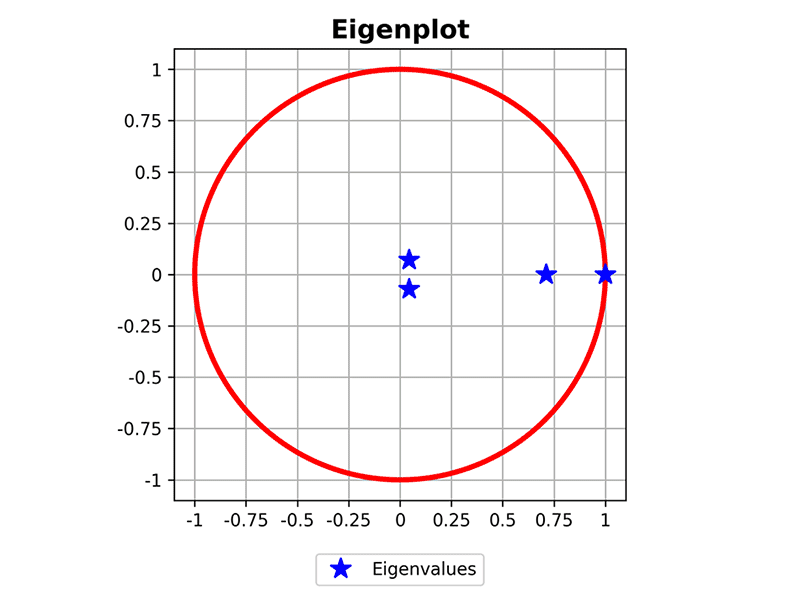A framework for discrete-time Markov chains analysis.
Project description
PyDTMC is a full-featured, lightweight library for discrete-time Markov chains analysis. It provides classes and functions for creating, manipulating, simulating and visualizing markovian stochastic processes.
| Status: |



|
| Info: |



|
| PyPI: |




|
| Conda: |




|
| Donation: |

|
Requirements
The Python environment must include the following packages:
The package Sphinx is required for building the package documentation. The package pytest is required for performing unit tests. For a better user experience, it's recommended to install Graphviz and pydot before using the plot_graph function.
Installation & Upgrade
PyPI:
$ pip install PyDTMC
$ pip install --upgrade PyDTMC
Git:
$ pip install https://github.com/TommasoBelluzzo/PyDTMC/tarball/master
$ pip install --upgrade https://github.com/TommasoBelluzzo/PyDTMC/tarball/master
$ pip install git+https://github.com/TommasoBelluzzo/PyDTMC.git#egg=PyDTMC
$ pip install --upgrade git+https://github.com/TommasoBelluzzo/PyDTMC.git#egg=PyDTMC
$ conda install -c conda-forge pydtmc
$ conda update -c conda-forge pydtmc
$ conda install -c tommasobelluzzo pydtmc
$ conda update -c tommasobelluzzo pydtmc
Usage
The core element of the library is the MarkovChain class, which can be instantiated as follows:
>>> p = [[0.2, 0.7, 0.0, 0.1], [0.0, 0.6, 0.3, 0.1], [0.0, 0.0, 1.0, 0.0], [0.5, 0.0, 0.5, 0.0]]
>>> mc = MarkovChain(p, ['A', 'B', 'C', 'D'])
>>> print(mc)
DISCRETE-TIME MARKOV CHAIN
SIZE: 4
RANK: 4
CLASSES: 2
> RECURRENT: 1
> TRANSIENT: 1
ERGODIC: NO
> APERIODIC: YES
> IRREDUCIBLE: NO
ABSORBING: YES
REGULAR: NO
REVERSIBLE: NO
Below a few examples of MarkovChain properties:
>>> print(mc.is_ergodic)
False
>>> print(mc.recurrent_states)
['C']
>>> print(mc.transient_states)
['A', 'B', 'D']
>>> print(mc.steady_states)
[array([0.0, 0.0, 1.0, 0.0])]
>>> print(mc.is_absorbing)
True
>>> print(mc.fundamental_matrix)
[[1.50943396, 2.64150943, 0.41509434]
[0.18867925, 2.83018868, 0.30188679]
[0.75471698, 1.32075472, 1.20754717]]
>>> print(mc.kemeny_constant)
5.547169811320755
>>> print(mc.entropy_rate)
0.0
Below a few examples of MarkovChain methods:
>>> print(mc.absorption_probabilities())
[1.0 1.0 1.0]
>>> print(mc.expected_rewards(10, [2, -3, 8, -7]))
[-2.76071635, -12.01665113, 23.23460025, -8.45723276]
>>> print(mc.expected_transitions(2))
[[0.085, 0.2975, 0.0000, 0.0425]
[0.000, 0.3450, 0.1725, 0.0575]
[0.000, 0.0000, 0.7000, 0.0000]
[0.150, 0.0000, 0.1500, 0.0000]]
>>> print(mc.first_passage_probabilities(5, 3))
[[0.5000, 0.0000, 0.5000, 0.0000]
[0.0000, 0.3500, 0.0000, 0.0500]
[0.0000, 0.0700, 0.1300, 0.0450]
[0.0000, 0.0315, 0.1065, 0.0300]
[0.0000, 0.0098, 0.0761, 0.0186]]
>>> print(mc.hitting_probabilities([0, 1]))
[1.0, 1.0, 0.0, 0.5]
>>> print(mc.mean_absorption_times())
[4.56603774, 3.32075472, 3.28301887]
>>> print(mc.mean_number_visits())
[[0.50943396, 2.64150943, inf, 0.41509434]
[0.18867925, 1.83018868, inf, 0.30188679]
[0.00000000, 0.00000000, inf, 0.00000000]
[0.75471698, 1.32075472, inf, 0.20754717]]
>>> print(mc.walk(10, seed=32))
['D', 'A', 'B', 'B', 'C', 'C', 'C', 'C', 'C', 'C', 'C']
>>> walk = ["A"]
>>> for i in range(1, 11):
... current_state = walk[-1]
... next_state = mc.next_state(current_state, seed=32)
... print(f'{i:02} {current_state} -> {next_state}')
... walk.append(next_state)
1) A -> B
2) B -> C
3) C -> C
4) C -> C
5) C -> C
6) C -> C
7) C -> C
8) C -> C
9) C -> C
10) C -> C
Plotting functions can provide a visual representation of MarkovChain instances; in order to display the output of plots immediately, the interactive mode of Matplotlib must be turned on:
>>> plot_eigenvalues(mc)
>>> plot_graph(mc)
>>> plot_redistributions(mc, 10, plot_type='heatmap', dpi=300)
>>> plot_redistributions(mc, 10, plot_type='projection', dpi=300)
>>> plot_walk(mc, 10, plot_type='histogram', dpi=300)
>>> plot_walk(mc, 10, plot_type='sequence', dpi=300)
>>> plot_walk(mc, 10, plot_type='transitions', dpi=300)
Project details
Release history Release notifications | RSS feed
Download files
Download the file for your platform. If you're not sure which to choose, learn more about installing packages.












